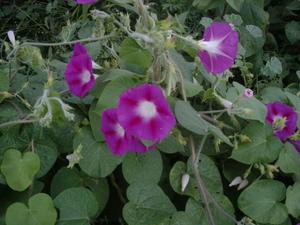Certain dahlia varieties can be quite expensive. By propagating your own, you can easily expand a flower garden and save money. Root division is one of the easiest propagation methods, and can be done in early spring. Individual dahlia tubers can be separated from the main clump, and grown on as well. Future articles will discuss other ways of propagating dahlias, such as starting from seed and basal stem cuttings.
In warm climates, such as USDA zones 8 and above, dahlias are most often left in the ground over the winter and divided in the spring. In colder areas, the plants are usually dug in the fall and stored until spring. In both cases, the technique is the same.
Remove as much dirt from the cluster of tubers as possible. Each tuber is connected by a thin stem to the main crown. An established dahlia clump may have two to four separate crowns, or more. The simplest division method is to gently ease the crowns apart, using a pruners to help along the process. Crown division produces larger plants initially that will bloom much sooner than dahlias grown from single tubers. Each crown division can be planted outside if the weather is warm enough, or potted up and grown indoors under lights. Starting the dahlias early in the season under a grow light will encourage faster development and earlier blooming. Dahlias started indoors should be acclimated gradually to life outside. They can be placed in a partially shaded area for part of the day, then moved back inside. After one to two weeks of this treatment, they are ready to be planted in the garden.
Propagating dahlias from tubers has the advantage of quickly producing many plants, although they may not bloom the first year. Remove the dirt from the dahlia clumps as with root division. Carefully examine each tuber. There should be at least one actively growing bud, or ‘eye’ on each one. The eye location will be on the thin end of the tuber closest to the crown. Cut the tubers above the eye, removing them from the main crown. The tubers are then potted up, with the growth bud covered very shallowly or slightly exposed. Again, if the weather is mild enough the tubers can be grown outdoors, but starting them inside increases growth and accellerates blooming. If the tubers are potted up, after all danger of frost is past they can be planted in the garden. Tubers are initially planted shallowly to encourage light to reach the growth buds. Once they have actively started to grow, they can be planted slightly deeper in the garden or in a pot.
A mild fertilizer for flowering perennials will help to get the new plants off to a good start. Plants started from tubers may need one to two years to bloom, and can be divided again in about three years. Crown divisions will usually put on enough growth so that they will bloom immediately. Crown divisions can be divided every year, and more propagation material collected.








